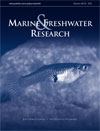Marine and Freshwater Research
Volume 63
Number 12 2012
Proliferation of invasive species can be influenced by their susceptibility to predators. We found that although capable of consuming non-native Pacific oysters, a whelk native to south-eastern Australia preferentially consumed native Sydney rock oyster when offered a choice between the two. Our results add to growing evidence that the Pacific oyster invasion of south-eastern Australia is currently causing minimal disruption to trophic relationships in eastern Australian estuaries.
Eastern mosquitofish (Gambusia holbrooki) were introduced into many countries including Australia for mosquito control, where they have become an invasive and destructive pest. We investigated the spread G. holbrooki in south-eastern Australia by using genetic markers and found low genetic diversity but marked differences in genetic constitution among populations. These data validate historical records of G. holbrooki populations spreading north to south.
The use of caudal markings for the photographic identification of white sharks relies on the assumption that the markings are permanent and stable. This paper provides evidence that caudal markings are subject to a degree of change through the process of melanism. This has implications in the continued use of such pigmentation markings in identification studies of white sharks.
Better flow delivery can improve the functioning of lowland regulated rivers. This study focussed on the relationship between river discharge and DOC; a positive relationship existed between discharge and DOC load, although antecedent flow conditions have the potential to influence DOC load delivery. Appropriate flow management of regulated lowland rivers towards more ‘natural’ regimes has the potential to benefit river functioning (switching from autochthonous to allochthonous conditions) and ecology.
Growth rates of larval and early juvenile Chrysophrys auratus were estimated from daily otolith increments. Fish with a short pelagic larval duration (≤20 days) grew faster than did fish with a long pelagic larval duration (>24 days), and growth also varied between sites. Localised variation in growth may help to explain differences in recruitment among populations.
Environmental variables can greatly affect the spatial distribution of Thunnus obesus. Integrated habitat index models were built to describe the relationship between environmental variables; weighted average temperature and dissolved oxygen significantly affect the spatial distribution of this species. The present study method could be used to predict the spatial distribution of other pelagic fishes.
Spawning aggregations of lanternfish (Diaphus danae) in the northwestern Coral Sea were sampled by mid-water trawling for the first time. Bigeye and yellowfin tuna, which form spawning aggregations at the same time, feed intensely on the lanternfish aggregations. Fisheries statistics indicated that lanternfish-tuna spawning aggregations occur annually in the Queensland Trough. The ecological processes supporting high lanternfish biomass in this oligotrophic environment require further study.
Riparian zones can act as a buffer for stream ecosystems. The present study investigated the presence of C4 carbon in agricultural watersheds and in their respective aquatic food webs. A significant increase in C4 carbon was detected in watersheds lacking a preserved vegetation in the riparian zones. These results demonstrate the importance of riparian forests and support efforts to preserve riparian corridors.
Anisakid nematodes can cause severe gastroenteritis and allergic reactions to seafood in humans. A survey was undertaken to characterise larval anisakid nematodes present in teleosts at Lizard Island on the northern Great Barrier Reef. This study provides some insights into the distribution of larval anisakid nematodes in coral-reef fishes and a basis for future investigations of anisakid populations in marine fishes.




